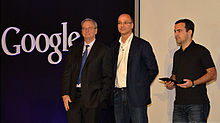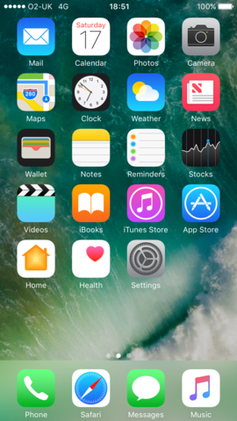Android is a mobile operating system developed by Google, based on the Linux kernel and designed primarily for touchscreen mobile devices such as smartphones and tablets. Android's user interface is mainly based on direct manipulation, using touch gestures that loosely correspond to real-world actions, such as swiping, tapping and pinching, to manipulate on-screen objects, along with a virtual keyboard for text input. In addition to touchscreen devices, Google has further developed Android TV for televisions, Android Auto for cars, and Android Wear for wrist watches, each with a specialized user interface. Variants of Android are also used on notebooks, game consoles, digital cameras, and other electronics.
Android has the largest installed base of all operating systems (OS) of any kind.Android has been the best selling OS on tablets since 2013, and on smartphones it is dominant by any metric.
Initially developed by Android, Inc., which Google bought in 2005,Android was unveiled in 2007 along with the founding of the Open Handset Alliance – a consortium of hardware, software, and telecommunication companies devoted to advancing open standards for mobile devices.As of July 2013, the Google Play store has had over one million Android applications ("apps") published – including many "business-class apps"that rival competing mobile platforms – and as of May 2016 over 65 billion applications downloaded.An April–May 2013 survey of mobile application developers found that 71% of developers create applications for Android,and a 2015 survey found that 40% of full-time professional developers see Android as their priority target platform, which is comparable to Apple's iOS on 37% with both platforms far above others.In September 2015, Android had 1.4 billion monthly active devices.
Android's source code is released by Google under an open source license, although most Android devices ultimately ship with a combination of free and open source and proprietary software, including proprietary software required for accessing Google services.Android is popular with technology companies that require a ready-made, low-cost and customizable operating system for high-tech devices.Its open nature has encouraged a large community of developers and enthusiasts to use the open-source code as a foundation for community-driven projects, which deliver updates to older devices, add new features for advanced users or bring Android to devices originally shipped with other operating systems. The success of Android has made it a target for patent (and copyright) litigation as part of the so-called "smartphone wars" between technology companies.
History
Android, Inc. was founded in Palo Alto, California in October 2003 by Andy Rubin (co-founder of Danger),Rich Miner (co-founder of Wildfire Communications, Inc.),Nick Sears (once VP at T-Mobile), and Chris White (headed design and interface development at WebTV to develop "smarter mobile devices that are more aware of its owner's [sic] location and preferences".The early intentions of the company were to develop an advanced operating system for digital cameras. Though, when it was realized that the market for the devices was not large enough, the company diverted its efforts toward producing a smartphone operating system that would rival Symbian and Microsoft Windows Mobile.Despite the past accomplishments of the founders and early employees, Android Inc. operated secretly, revealing only that it was working on software for mobile phones.That same year, Rubin ran out of money. Steve Perlman, a close friend of Rubin, brought him $10,000 in cash in an envelope and refused a stake in the company.
In July 2005, Google acquired Android Inc. for at least $50 million. Its key employees, including Rubin, Miner and White, stayed at the company after the acquisition.Not much was known about Android Inc. at the time, but many assumed that Google was planning to enter the mobile phone market with this move.At Google, the team led by Rubin developed a mobile device platform powered by the Linux kernel. Google marketed the platform to handset makers and carriers on the promise of providing a flexible, upgradeable system. Google had lined up a series of hardware component and software partners and signaled to carriers that it was open to various degrees of cooperation on their part.
Speculation about Google's intention to enter the mobile communications market continued to build through December 2006.An earlier prototype codenamed "Sooner" had a closer resemblance to a BlackBerry phone, with no touchscreen, and a physical, QWERTY keyboard, but was later re-engineered to support a touchscreen, to compete with other announced devices such as the 2006 LG Prada and 2007 Apple iPhone.In September 2007, InformationWeek covered an Evalueserve study reporting that Google had filed several patent applications in the area of mobile telephony.
On November 5, 2007, the Open Handset Alliance, a consortium of technology companies including Google, device manufacturers such as HTC, Sony and Samsung, wireless carriers such as Sprint Nextel and T-Mobile, and chipset makers such as Qualcomm and Texas Instruments, unveiled itself, with a goal to develop open standards for mobile devices.That day, Android was unveiled as its first product, a mobile device platform built on the Linux kernel.The first commercially available smartphone running Android was the HTC Dream, released on October 22, 2008.
Since 2008, Android has seen numerous updates which have incrementally improved the operating system, adding new features and fixing bugs in previous releases. Each major release is named in alphabetical order after a dessert or sugary treat; for example, version 1.5 "Cupcake" was followed by 1.6 "Donut". In 2010, Google launched its Nexus series of devices – a line of smartphones and tablets running the Android operating system, and built by manufacturing partners. HTC collaborated with Google to release the first Nexus smartphone,the Nexus One. Google has since updated the series with newer devices, such as the Nexus 5 phone and the Nexus 7 tablet. Google releases the Nexus phones and tablets to act as their flagship Android devices, demonstrating Android's latest software and hardware features. From 2013 until 2015, Google offered several Google Play Edition devices over Google Play. While not carrying the Google Nexus branding, these were Google-customized Android phones and tablets that also ran the latest version of Android, free from manufacturer or carrier modifications.
From 2010 to 2013, Hugo Barra served as product spokesperson, representing Android at press conferences and Google I/O, Google’s annual developer-focused conference. Barra's product involvement included the entire Android ecosystem of software and hardware, including Honeycomb, Ice Cream Sandwich, Jelly Bean and KitKat operating system launches, the Nexus 4 and Nexus 5 smartphones, the Nexus 7 and Nexus 10 tablets,and other related products such as Google Now and Google Voice Search, Google’s speech recognition product comparable to Apple’s Siri.In 2013, Barra left the Android team for Chinese smartphone maker Xiaomi.The same year, Larry Page announced in a blog post that Andy Rubin had moved from the Android division to take on new projects at Google.He was replaced by Sundar Pichai who became the new head of Android and Chrome OS,and, later, by Hiroshi Lockheimer when Pichai became CEO of Google.
In 2014, Google launched Android One, a line of smartphones mainly targeting customers in the developing world. In May 2015, Google announced Project Brillo as a cut-down version of Android that uses its lower levels (excluding the user interface), intended for the "Internet of Things" (IoT) embedded systems.
University of Cambridge research in 2015, concluded that almost 90% of Android phones in use had known but unpatched security vulnerabilities due to lack of updates and support.In a year since (mid-2015) that report, well over a billion Android smartphones have been sold (more than the just over billion sold in 2014); and Android 5.0 (with better security) and later, went from 5.4% market share to currently over half, which means that the 90% number must be very outdated; those phones now very likely represent less than half of all Android phones. Recent devices do get security updates;Android 5.0 introduced an improved centralized update system.




















